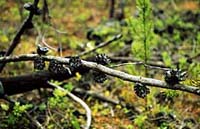

![[PARTS OF A TREE - FLOWERS AND CONES HIGHLIGHTED]](../../media/drawings/tree_parts_flowers.gif) Besides its branches, roots, and leaves,
a mature tree grows one other important structure - the
flower (or cone, in the case of evergreens). These are the reproductive
structures from which the seeds are produced. Fast-growing species
may mature and produce seeds after as little as 5 to 10 years'
growth, while other species take 30 to 40 years to mature. A certain
size is needed before flowering takes place, and suppressed trees
may not flower even at an age of 50 to 100 years or more. With
the growth of flowers, fruit, and seeds, the life cycle of the
tree comes full circle. The seeds are dispersed by wind, water,
or animals, and the few that find a suitable spot will germinate
and begin their journeys of growth toward the sun.
Besides its branches, roots, and leaves,
a mature tree grows one other important structure - the
flower (or cone, in the case of evergreens). These are the reproductive
structures from which the seeds are produced. Fast-growing species
may mature and produce seeds after as little as 5 to 10 years'
growth, while other species take 30 to 40 years to mature. A certain
size is needed before flowering takes place, and suppressed trees
may not flower even at an age of 50 to 100 years or more. With
the growth of flowers, fruit, and seeds, the life cycle of the
tree comes full circle. The seeds are dispersed by wind, water,
or animals, and the few that find a suitable spot will germinate
and begin their journeys of growth toward the sun.
Trees of either class may contain both female
and male reproductive organs or may possess only one kind. In
the latter case, a tree of the opposite gender would be required
in order that pollination and then fertilization
could take place. - pollination - is the transfer of pollen (the male gametophyte or sex cell) from the male sex organ of the plant to the female sex organ of the plant. Pollen may be transferred by wind, rain, insects, birds or even humans, as in artificial pollination. Self-pollinating plants would contain both female and male sex cells. Pollination may or may not result in fertilization.
- fertilization - is the actual joining of the egg (female sex cell) and sperm (male sex cell) to form a new individual. The name for the fertilized egg is zygote. The fertilization process results in the eventual formation of a seed (located in a cone or a fruit), carrying the characterisitics of both parent plants.
|

